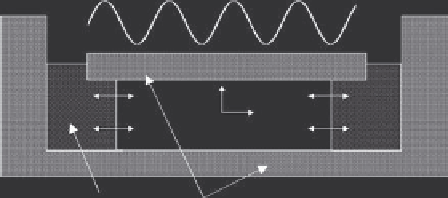Biomedical Engineering Reference
In-Depth Information
Applied cyclic load
z
r
Cartilage disc
Bath solution containing IGF-I
Impermeable platens
FIGURE 11.3
A schematic diagram of an axisymmetrical cylindrical cartilage disc undergo-
ing cyclic deformation between frictionless impermeable platens. The cartilage
is within a bath containing IGF-I.
With consideration of earlier assumptions, the governing equations (11.12)
and (11.17) can be rewritten in radial coordinates as
∂t
−
κ
r
∂
2
p
= 0
v
r
r
+
∂v
r
∂r
+
∂ε
z
∂r
2
+
1
∂p
∂r
(11.24)
r
∂
2
c
I
∂r
2
+
φ
f
v
r
−
κ
r
∂p
∂r
∂c
I
∂r
φ
f
∂c
I
∂c
I
∂r
+
1
r
φ
f
D
I
∂t
−
= 0
(11.25)
In the radial IGF-I transport equation (11.25), the first term represents
the change of concentration of IGF-I with respect to time; the second term
represents the IGF-I transported by diffusion, and the third and fourth terms
describe the contribution of mechanical loading and advection in the deform-
ing porous media.
Furthermore, under this unconfined, axisymmetric loading geometry, the
elastic stress
σ
e
in equation (11.19) reduces to
+
λ
2
u
r
∂z
⎡
⎣
⎤
⎦
H
+
A
∂u
r
+
∂u
z
0
0
∂r
+
λ
2
∂u
r
∂r
∂z
[
σ
e
]=
H
+
A
u
r
+
∂u
z
0
0
+
λ
2
u
r
∂r
H
−A
∂u
z
+
∂u
r
0
0
∂z
(11.26)
where
H
+
A
=
λ
+1
+2
µ
and
H
−A
=
λ
−
1
+2
µ
are the tensile and compressive
aggregate modulus, respectively. Thus, the radial component of the balance
of linear momentum equation (11.21) can be simply written as
∂r
+
H
+
A
= 0
+
∂
2
u
r
∂r
2
∂p
u
r
r
2
+
1
∂u
r
∂r
−
−
(11.27)
r


Search WWH ::

Custom Search